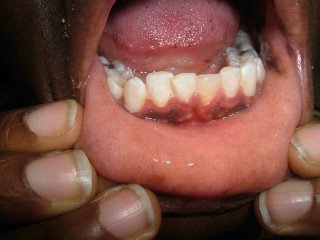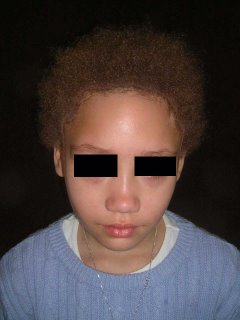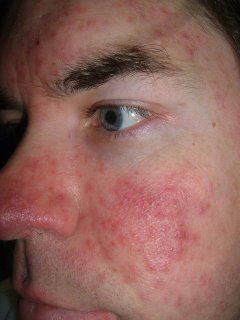This 50 yo man has a three year history of a nail dystrophy.
I asked him to write out a detailed history:
"Started 18 months ago. Might well have contracted the condition while handling and cutting blocks of cheese as part of my former job. I used to handle and work with dozens of varieties of often moldy cheeses for three hours per week.
The condition began with a raised red ridge near the thumbnail. It was a connected series of raised red lumps about 1 to 2cm long and 3 or 4mm wide. This condition traveled progressively up and around my thumb. It always progressed one way up my thumb with the old area healing. It became a migrating „"ing of red". This went on for about six months. Often complete healing would occur, but then it would come up again right where it had left off and progress some distance more. Eventually it completely died out a little ways into the palm. There has been no trace of this symptom for a year now.
But starting also about 18 months ago the thumbnail became discolored (white and yellowish) and detached from the skin underneath. I've cut the thumbnail all the way back to the base in the hopes it will grow out correctly, but it remains detached from the skin underneath. Also the nail is misshapen: it is raised in some places and sunken in the middle. This has been the growth pattern for more than a year now. The skin underneath is clean but has a slight coating of what seems to be nail tissue on it, thus making it harder for the nail to attach itself. The nail is sound, just wavy and not attached underneath; because it is unattached underneath it is not pink, but rather it is white.

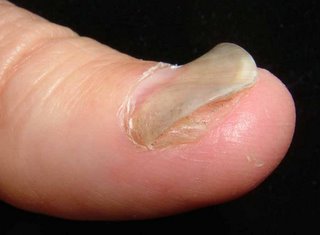
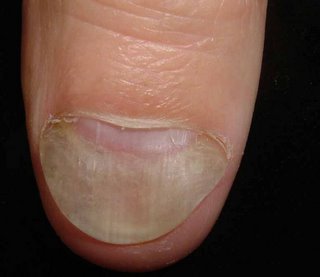
In the dermatology office there have been 2 negative KOH preps and a negative fungal culture. I did see some hyphae on one occasion. Ths question is: Is this a variant of funal nail disease, or are we dealing with onycholysis alone.
Your thoughts are appreciated.
I asked him to write out a detailed history:
"Started 18 months ago. Might well have contracted the condition while handling and cutting blocks of cheese as part of my former job. I used to handle and work with dozens of varieties of often moldy cheeses for three hours per week.
The condition began with a raised red ridge near the thumbnail. It was a connected series of raised red lumps about 1 to 2cm long and 3 or 4mm wide. This condition traveled progressively up and around my thumb. It always progressed one way up my thumb with the old area healing. It became a migrating „"ing of red". This went on for about six months. Often complete healing would occur, but then it would come up again right where it had left off and progress some distance more. Eventually it completely died out a little ways into the palm. There has been no trace of this symptom for a year now.
But starting also about 18 months ago the thumbnail became discolored (white and yellowish) and detached from the skin underneath. I've cut the thumbnail all the way back to the base in the hopes it will grow out correctly, but it remains detached from the skin underneath. Also the nail is misshapen: it is raised in some places and sunken in the middle. This has been the growth pattern for more than a year now. The skin underneath is clean but has a slight coating of what seems to be nail tissue on it, thus making it harder for the nail to attach itself. The nail is sound, just wavy and not attached underneath; because it is unattached underneath it is not pink, but rather it is white.



In the dermatology office there have been 2 negative KOH preps and a negative fungal culture. I did see some hyphae on one occasion. Ths question is: Is this a variant of funal nail disease, or are we dealing with onycholysis alone.
Your thoughts are appreciated.








